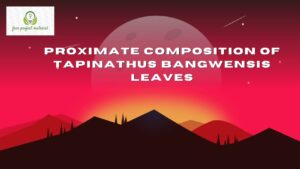ABSTRACTS
The aim of this study was to determine the mineral content of Xanthosoma sagittifolium treated with leaf extract of Alchornea laxiflora. The analysis was carried out using standard analytical methods. The result of the study revealed the following; For test sample : Iron (Fe)(8.56 ± 0.008 mg/kg), Copper (Cu)(14.19 ± 0.120mg/kg), Manganese (Mn)(0.87 ± 0.004mg/kg), Zinc (Zn)(0.56 ± 0.006mg/kg), Potassium (K)(17.24 ± 0.035mg/kg), Magnesium (Mg)(14.11 ± 0.006mg/kg), Calcium (Ca)(25.37 ± 0.011mg/kg), Sodium (Na)(11.10 ± 0.003mg/kg) and Phosphorus (P)(32.71 ± 0.014mg/kg) while for control : Iron (Fe)(3.10 ± 0.002mg/kg), Copper (Cu)(0.72 ± 0.001mg/kg), Manganese (Mn)(0.51 ± 0.001mg/kg), Zinc (Zn)(0.35 ± 0.001mg/kg), Potassium (K)(14.75 ± 0.284mg/kg), Manganese (Mg)(23.24 ± 0.004mg/kg), Calcium (Ca)(16.07 ± 0.002mg/kg), Sodium (Na)(24.12 ± 0.004mg/kg) and Phosphorus (P)(14.11 ± 0.014mg/kg). This result indicates that the treatment of Xanthosoma sagittifolium with the leaves extract greatly increased the mineral content of Xanthosoma sagittifolium, except for Mg and Na which recorded a reduction in which it was attributed to the effect of processing techniques. Therefore, it may be recommended that the consumption of these combined preparation is advisable due to the high content of Iron (Fe) and Copper (Cu) in the leaves of Alchornea laxiflora. Alchornea laxiflora leaves can be taken to treat inflammatory and infectious diseases and also in industrial utilization as a source of Iron (Fe) and Copper (Cu) supplement.
TABLE OF CONTENTS
TITLE PAGE- – – – – – – – – i
CERTIFICATION- – – – – – – – ii
DEDICATION- – – – – – – – – iii
ACKNOWLEDGEMENTS- – – – – – – iv
ABSTRACTS- – – – – – – – – v
TABLE OF CONTENTS- – – – – – – vi
CHAPTER ONE: INTRODUCTION
1.1 Background of the study- – – – – – – 1
1.2 Aim and objectives of the study- – – – – – 3
1.3 Scope and limitations- – – – – – – 4
1.4 Definition of related terms- – – – – – – 4
CHAPTER TWO: LITERATURE REVIEW
2.1 Botanical Classification of Alchornea laxiflora– – – 6
2.1.1Description of Alchornea laxiflora– – – – – 6
2.1.2Phytoconstituents of Alchornea laxiflora– – – – 8
2.1.3 Medicinal uses of Alchornea laxiflora– – – – – 8
2.2 Xanthosoma sagittifolium– – – – – – – 9
2.2.1 Description of Xanthosoma sagittifolium– – – – 10
2.2.2 Classes of Xanthosoma sagittifolium– – – – – 11
2.2.3 Description and uses of Xanthosoma sagittifolium– – – 12
2.3 Mineral element- – – – – – – – 14
2.3.1Calcium- – – – – – – – – 16
2.3.2 Phosphorus- – – – – – – – – 17
2.3.3 Potassium- – – – – – – -* – 18
2.3.4 Magnesium- – – – – – – – – 20
2.3.5Copper- – – – – – – – – 21
2.3.6 Iron- – – – – – – – – – 23
2.3.7 Manganese- – – – – – – – – 25
2.3.8 Zinc- – – – – – – – – – 26
2.3.9 Sodium- – – – – – – – – 28
CHAPTER THREE: MATERIALS AND METHODS
3.1 Materials – – – – – – – 30
3.1.1 Chemical Used – – – – – – – 30
3.2 Methods – – – – – – – – 30
3.2.1 Standard Analytical Method – – – – – 30
3.2.2 Method of Sample Collection – – – – – 31
3.2.3 Preparation of Samples – – – – – – 31
3.3 Analytical Procedure – – – – – – 32
3.4 Statistical Analysis – – – – – – 32
CHAPTER FOUR: RESULT AND DISCUSSION
4.1 Result- – – – – – – – – – 34
4.2 Discussion- – – – – – – – – 35
CHAPTER FIVE: CONCLUSION AND RECOMMENDATIONS
5.1 Conclusion- – – – – – – – – 43
5.2 Recommendations- – – – – – – – 43
5.3 Suggestion for further studies- – – – – – 44
References
CHAPTER ONE
INTRODUCTION
1.1 Background of the study
Nutrients are minerals which are required in minute quantities for a healthy and effective growth of cellular components and tissue functions through its role in cellular metabolism and consequent generation of ATP (Cora et al., 2011).
Minerals are essential nutrients and represent about 5-6% of the total body weight. They are categorized as major or macro minerals and the trace or micro minerals and have been found to be useful as structural and regulatory molecule that have also taken active parts in many metabolic and immune functions. Thus, their deficiencies can result to serious health issues (Ojewole, 2004).
Micronutrient malnutrition is common among the rural poor populace of developing countries of the world. It diminishes immune function and thus, predisposes a child to infections such as diarrhea a leading cause of death among children aged less than five (5) years, delays full recovery, and increases the probability of development of severe illness. This practice of using plants in the treatment of diverse forms of diseases plaguing mankind is predominant among those in the low income regions of developing countries (Joseph et al., 2015).
Over the years, medicinal plants have been recognized to be of great importance to the health of individuals and communities. In traditional medicine of Nigeria, Alchornea laxiflora leaf is one of the plants used in the management of anemia without scientific credence to its efficacy. Alchorne alaxiflora (Benth) (Euphorbiaceae) is a forest understory tree about 6m high growing in Nigeria. Alchornea laxiflora is a deciduous shrub or small tree, with smooth bark, pale grey and flaking. Leaves are alternate, elliptic-lanceolate to oblong-oblanceolate up to 17x8cm, acuminate, 3-veineed from the base, thinly textured, light green, turning an attractive yellow or red in dry season; margin is shallowly crenate-serrate. Flowers are in axillary spikes, unisexual on the same plant. The reddish bracts are more conspicuous than the small flowers. Fruit is a 2-4-lobed capsule, 5-7mm in diameter, thinly woody, blackish-brown. In spite of its large proportional usage in the preparation of local medicine, attempts have not been made (towards sustaining its supply) to domesticate it (Shittu, 2013).
Alchornealaxiflora is also found in other part of Africa. The leaves play important role in the preservation of kolanuts, stem and branchlets are also used in Nigeria as chewing sticks. Decoction of the leaves is used in the treatment and management of inflammatory and infectious diseases as well as an important component of herbal antimalarial (Adewole, 1993), antibacterial (Lamikanra et al., 1990), anti-inflammatory and antimicrobial formulation (Ogundipe et al., 1999).
1.2 Aim and objectives of the study
The aim of this research project is to determine the mineral element content of Xanthosoma sagittifolium treated with Alchornea laxiflora crude leaf extract.
The objectives of this research project are to;
- Determine the mineral contents of Xanthosoma sagittifolium treated with Alchornea laxiflora crude leaf extract.
- Compare the mineral (Fe, Cu, Mn, Zn, K, Mg, Ca, Na, P) composition with the Required Dietary Allowance Standard and with the work of other researchers.
- Make recommendations and suggestions for further studies based on the result obtained from this analysis.
1.3 Scope and Limitation
The design of this research project is to investigate and determine the mineral element contents of Xanthosoma sagittifolium treated with Alchornea laxiflora crude leaf extract.
Therefore, due to time, lack of adequate facilities and financial constraint, this research project limited to the determination of mineral element contents Xanthosoma sagittifolium treated with Alchornea laxiflora crude leaf extract.
1.4 Definition of Related Terms
Minerals: Minerals are chemical elements required as an essential nutrient by organisms to perform functions necessary for life.
Alchornea laxiflora: Alchornea laxiflora is a deciduous, upright small tree about 7-10m tall and common in evergreen forests. The flowers are unisexual and the fruits are even, dark green, brown, slightly hairy and has three seeds.
Xanthosoma sagittifolium: Xanthosoma sagittifolium is a tropical plant grown primarily for its edible corms, a root vegetable most commonly known as taro, among many other names.
Determination: The process of establishing something exactly by calculation or research.
Extract: A preparation containing the active ingredient of a substance in concentration form.
Element: A substance that cannot be broken down into simpler substances by chemical means.



